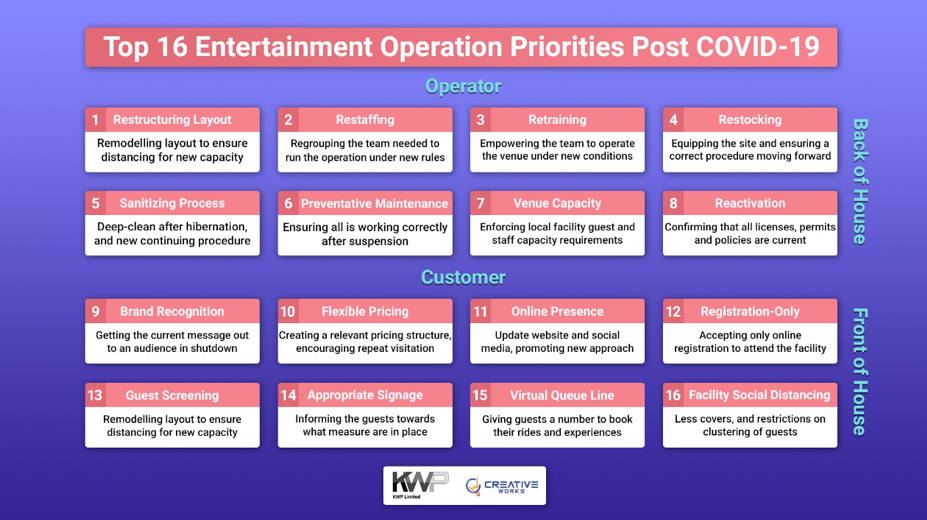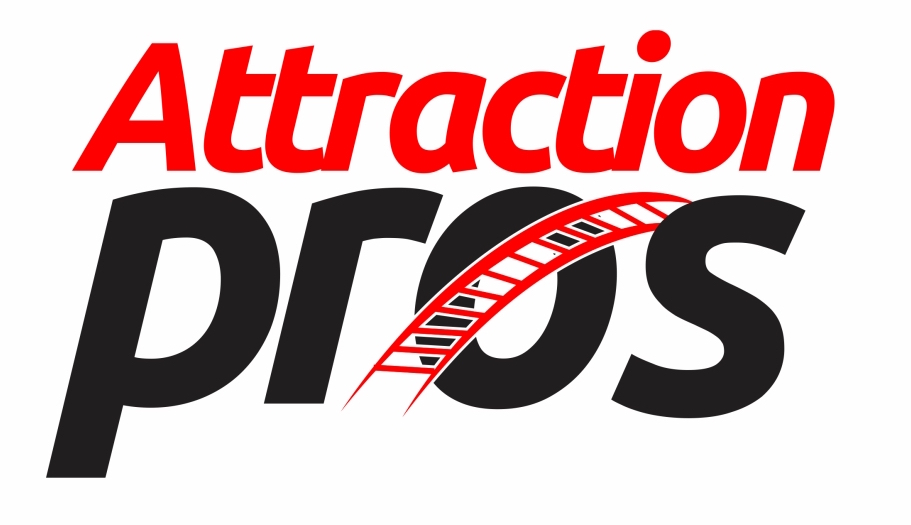
Operators Guide: Priorities for Entertainment Operators Post-Lockdown
Immersive Out-of-Home Entertainment specialist, Kevin Williams of KWP, applies recent research and industry developments towards creating the first in an informative guide to the key issues that will shape the “new Normal” for international entertainment facility operators, under the shadow of COVID-19 restrictions.
For many entertainment executives the key consideration after family and loved ones, is the issue of the continuation of their businesses, in the face of the Global Health crisis that has befallen the industry. After a prolonged period of isolation and hibernation, the process must now start to plan the next move. While the entertainment trade associations and numerous services have offered observations on the situation, there is a need for action to be taken that focuses on the “new normal” that the social entertainment industry now faces.
As part of our activities as a consultancy in the Out-of-Home entertainment arena, a number of clients have asked us to pay close attention to the market, collecting research on deployments in countries coming out of isolation, and looking at trends and guidelines being employed. Based on the collected information we compiled a breakdown of 16 essential points to use as a guide [Image], towards the needs for the entertainment industry to consider and apply in this planning process.

With the information sheet created for the trade, we start with the highlighting of “Restructuring Layout”. It has become obvious that with the downtime all venues will need to reconsider the layout and movement through the venue. Seen in Asia numerous sites have been requested to operate a lower capacity to avoid clusters of groups, ensuring some level of social distancing. These are all aspects for “Venue Capacity” under new restrictions.
The next consideration outlined in the guide is “Re-staffing” – while many facilities have placed staff on furlough, the need to start the process of reinstating team members and ascertain staffing numbers under the changed capacity, is essential. This also sees the need for new skill sets from the facility staff, as some duties change (as we will cover later in this overview). Associated with staffing, is the consideration of “Retraining” – a serious need to re-evaluate the approach by staff with guests, and to familiarize the team with the new processes that need to now be implemented post-lockdown.
One of the new activities will be the “Sanitizing Process”, with first the need for a deep-clean of the location after coming out of hibernation (also supporting the site inspection process). After this, a new procedure of cleaning the venue at the end of the day, and the new cleaning regime needed during the working day. The consideration of counter-tops, armrests and seats, in all high traffic areas, and new regular cleaning of touchscreens and e-payment terminals. The promotion of care the site is taking on a cleaning procedure, seen by guests and so installing trust in the operation.
Part of the process of coming out of lockdown for a re-opening location is the “Restocking” – establishing new lines of supply in a changed market, but also acquisition of new items such as increased cleaning materials. Also, a point of consideration with restocking is the ensuring of correct product acceptance into a site and ensuring that measures to clean this stock meets a “clean-in and clean-out” process.
A major activity in the recommencement of business is that of bringing the attractions and entertainment back online. The one aspect that most facilities have retained even in lockdown is “Preventative Maintenance”, and this procedure will be stepped up as the time for the proposed opening gets closer. Many amusement pieces and attractions are going to need unusual inspection having been left dormant for so long a time. And this leads to another aspect of the facility re-opening that of ensuring “Re-Activation” – ranging from the phone and Wi-Fi providers, to the operation permits, licenses and all-important insurance liabilities. These all need to be checked and confirmed as up-to-date, and not subject to change after a long period of inaction.
All the above points have dealt with what KWP refers to as “Back-of-House” – services and procedures that are invisible to the guest but ensure the entertainment offering. Now we move to “Front-of-House” – the elements that directly touch the guest.
The first of these points, as like preventative maintenance, should have still been carried out when the venue was in lock-down. Too many venues as soon as the businesses went into lockdown, suspended their web-services, to avoid taking ticket cancellations, and just left a place-holder sign stating the venue was closed due to the COIVID-19 incident. The need for “Brand Recognition” has never been stronger, as now all competitive entertainment venues are in the same predicament. The need to ensure that brand is kept in the guests’ minds is essential. And closer to the time, the need to promote the soft-opening and support of previous guests and community is needed through appropriate marketing, much of which will be driven by investing in a strong “Online Presence”.
Moving to the time of opening and you will have noticed we used the term “soft-opening” – it will be essential that with the new consideration and means of operation that a period of testing and evaluation is undertaken to ascertain what is working best. While promoting that the facility is back in action the need to consider a gradual process for staff and guests to become familiar with the new procedures needs to ensure flexibility. The elasticity also extends itself to the revenue stream of the location. With an audience coming out of a severe lock-down, and their disposable incomes under pressure, value for money is on many minds. An operator will have to consider the need for “Flexible Pricing”, creating appropriate pricing, but offering inducements through return-price-reductions, (essential for all sites to look at driving “repeat-visitation”).
The establishment of the brand through increased marketing will need to promote these new pricings and offers, all supported by the new increased online presence. And it is this presence that will promote one of the most drastic changes that some venues will have to consider #AfterLockdown. That being the deployment of a “Registration-Only” policy, with guests able to gain admittance only if they have booked online or have phone reservations. Under the new capacity limits, and the need to avoid clusters of guests arriving – as seen in Asia, sites are reverting to a no-walk-up policy, (a practise that had been instigated by some entertainment sites prior to the pandemic).
And it is at the door of the venue that the next new guest interaction will take place – with the need to consider “Guest Screening”. As seen at a number of large entertainment sites in China, and at a number of the other territories tentatively coming out of lockdown, the need to check the temperature of guests to ensure they are not exhibiting overt symptoms of the illness are employed. Similar to the process seen at some airports; while some venues look towards head thermometers, other sites are considering the deployment of CCTV thermal tracking systems.
Once inside and the most overt change that will strike guests is the removal of most queuing, with the deployment of “Virtual Que-line” – either using a simple take-a-ticket dispenser and waiting to be called. Or using smartphone Virtual-Que applications, many examples being available with social distancing components. The removal of guest clustering near rides, or walkways will be of serious consideration, and plays a part in the previously mentioned restructuring of layout, as part of the “Facility Social Distancing”. And with all this, there is the need for the operator to invest in “Appropriate Signage” – informing the guests on the new rules being employed, and the lengths being taken for their safety and security.
Finally, this leads us to the core research from this investigation – the situation facing the international entertainment scene is totally flexible, and is constantly changing, and will expect to become even more volatile as each territory comes closer to the partial lifting of quarantine regulations. As seen in Asia attempt to open certain cinemas and entertainment sites were quickly reversed in face of concerns in a spike in cases and possible second phase of illness.
As stated above, in considering the soft opening, there needs to be “flexibility” in the plan of action that operators look to employ, utilizing not just best judgement, but collecting information from numerous verifiable sources. Several leading amusement and attraction trade associations have compiled valuable resources that will act as a repository of information.
The creation of this first version of an operator guide to re-opening we worked in cooperation with facility and attraction provider specialists Creative Works. And we will continue to update to create an important primer towards the work needed to move ahead. Incorporating updates based on collected information, and governmental advice, and looking forward to receiving observations and advise from those at the sharp end of this process, adding to updated versions planned to follow.
We look forward to sharing the next version of this process soon. And once again, we wish all those at home, or working to provide the services that have become so important to us all, our best, and hope they are safe and secure.
Please contact KWP directly with any questions or suggestions – kwp@thestingerreport.com
Kevin Williams
Kevin Williams – a leading specialist in the immersive Out-of-Home entertainment industry, through his consultancy KWP Limited, specializing in interactive entertainment. Coming from a long career in the theme park, amusement and entertainment software industries, being an ex-Walt Disney Imagineer. Well known for his news service, The Stinger Report that has become a-must-read for those working or investing in the international market. Along with this, he is also a prolific writer with regular columns for the main trade publications in this market, along with presenting numerous conference sessions on the sector and its global impact. He is also the co-author of the only book on this aspect of the market, “The Out-of-Home Immersive Entertainment Frontier” – currently working on the next edition, schedule for publication soon.
